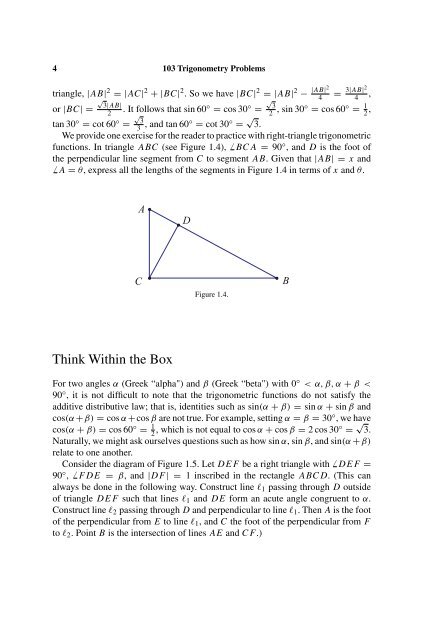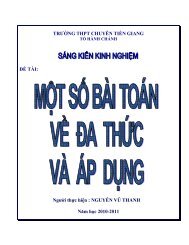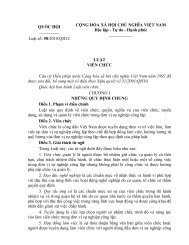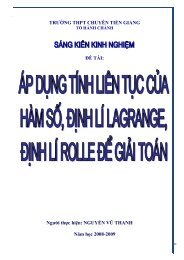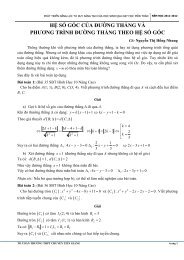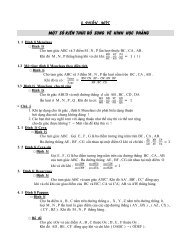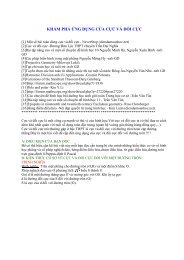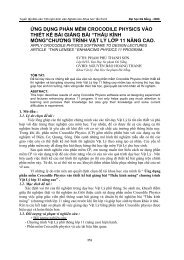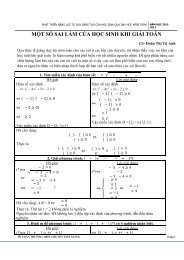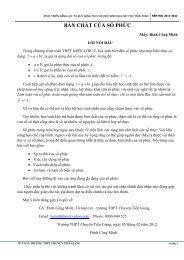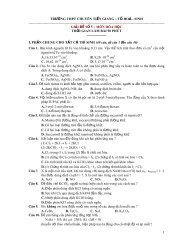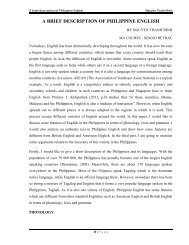- Page 3 and 4: About the Authors Titu Andreescu re
- Page 5 and 6: Titu Andreescu University of Wiscon
- Page 7 and 8: vi Contents Vectors 41 The Dot Prod
- Page 9 and 10: viii Preface Throughout MOSP, full
- Page 12 and 13: Abbreviations and Notation Abbrevia
- Page 14: 103 Trigonometry Problems
- Page 17: 2 103 Trigonometry Problems First w
- Page 21 and 22: 6 103 Trigonometry Problems By sett
- Page 23 and 24: 8 103 Trigonometry Problems Q A B P
- Page 25 and 26: 10 103 Trigonometry Problems for co
- Page 27 and 28: 12 103 Trigonometry Problems Furthe
- Page 29 and 30: 14 103 Trigonometry Problems (b) By
- Page 31 and 32: 16 103 Trigonometry Problems 15 10
- Page 33 and 34: 18 103 Trigonometry Problems such a
- Page 35 and 36: 20 103 Trigonometry Problems A A B
- Page 37 and 38: 22 103 Trigonometry Problems Soluti
- Page 39 and 40: 24 103 Trigonometry Problems A3 A1
- Page 41 and 42: 26 103 Trigonometry Problems It fol
- Page 43 and 44: 28 103 Trigonometry Problems Exampl
- Page 45 and 46: 30 103 Trigonometry Problems A F P
- Page 47 and 48: 32 103 Trigonometry Problems Soluti
- Page 49 and 50: 34 103 Trigonometry Problems [Menel
- Page 51 and 52: 36 103 Trigonometry Problems A B D
- Page 53 and 54: 38 103 Trigonometry Problems Likewi
- Page 55 and 56: 40 103 Trigonometry Problems new li
- Page 57 and 58: 42 103 Trigonometry Problems tail o
- Page 59 and 60: 44 103 Trigonometry Problems b = 26
- Page 61 and 62: 46 103 Trigonometry Problems −−
- Page 63 and 64: 48 103 Trigonometry Problems a way
- Page 65 and 66: 50 103 Trigonometry Problems small
- Page 67 and 68: 52 103 Trigonometry Problems z x F
- Page 69 and 70:
54 103 Trigonometry Problems (a) Ho
- Page 71 and 72:
56 103 Trigonometry Problems how ca
- Page 73 and 74:
58 103 Trigonometry Problems Soluti
- Page 75 and 76:
60 103 Trigonometry Problems then r
- Page 77 and 78:
62 103 Trigonometry Problems to tri
- Page 79 and 80:
64 103 Trigonometry Problems 5. Pro
- Page 81 and 82:
66 103 Trigonometry Problems (a) ta
- Page 83 and 84:
68 103 Trigonometry Problems (b) co
- Page 85 and 86:
70 103 Trigonometry Problems 40. Fi
- Page 88 and 89:
3 Advanced Problems 1. Two exercise
- Page 90 and 91:
3. Advanced Problems 75 9. Find the
- Page 92 and 93:
3. Advanced Problems 77 22. Let a 0
- Page 94 and 95:
3. Advanced Problems 79 35. Let x 1
- Page 96:
3. Advanced Problems 81 47. Let n b
- Page 99 and 100:
84 103 Trigonometry Problems 3. Com
- Page 101 and 102:
86 103 Trigonometry Problems Second
- Page 103 and 104:
88 103 Trigonometry Problems Soluti
- Page 105 and 106:
90 103 Trigonometry Problems and we
- Page 107 and 108:
92 103 Trigonometry Problems Soluti
- Page 109 and 110:
94 103 Trigonometry Problems (b) ta
- Page 111 and 112:
96 103 Trigonometry Problems then t
- Page 113 and 114:
98 103 Trigonometry Problems Soluti
- Page 115 and 116:
100 103 Trigonometry Problems By th
- Page 117 and 118:
102 103 Trigonometry Problems Euler
- Page 119 and 120:
104 103 Trigonometry Problems prove
- Page 121 and 122:
106 103 Trigonometry Problems Solut
- Page 123 and 124:
108 103 Trigonometry Problems 34. P
- Page 125 and 126:
110 103 Trigonometry Problems Solut
- Page 127 and 128:
112 103 Trigonometry Problems if x
- Page 129 and 130:
114 103 Trigonometry Problems and (
- Page 131 and 132:
116 103 Trigonometry Problems or si
- Page 133 and 134:
118 103 Trigonometry Problems Solut
- Page 135 and 136:
120 103 Trigonometry Problems imply
- Page 137 and 138:
122 103 Trigonometry Problems By Ga
- Page 140 and 141:
5 Solutions to Advanced Problems 1.
- Page 142 and 143:
5. Solutions to Advanced Problems 1
- Page 144 and 145:
5. Solutions to Advanced Problems 1
- Page 146 and 147:
5. Solutions to Advanced Problems 1
- Page 148 and 149:
5. Solutions to Advanced Problems 1
- Page 150 and 151:
5. Solutions to Advanced Problems 1
- Page 152 and 153:
5. Solutions to Advanced Problems 1
- Page 154 and 155:
5. Solutions to Advanced Problems 1
- Page 156 and 157:
5. Solutions to Advanced Problems 1
- Page 158 and 159:
5. Solutions to Advanced Problems 1
- Page 160 and 161:
5. Solutions to Advanced Problems 1
- Page 162 and 163:
5. Solutions to Advanced Problems 1
- Page 164 and 165:
5. Solutions to Advanced Problems 1
- Page 166 and 167:
5. Solutions to Advanced Problems 1
- Page 168 and 169:
5. Solutions to Advanced Problems 1
- Page 170 and 171:
5. Solutions to Advanced Problems 1
- Page 172 and 173:
5. Solutions to Advanced Problems 1
- Page 174 and 175:
5. Solutions to Advanced Problems 1
- Page 176 and 177:
5. Solutions to Advanced Problems 1
- Page 178 and 179:
5. Solutions to Advanced Problems 1
- Page 180 and 181:
5. Solutions to Advanced Problems 1
- Page 182 and 183:
5. Solutions to Advanced Problems 1
- Page 184 and 185:
5. Solutions to Advanced Problems 1
- Page 186 and 187:
5. Solutions to Advanced Problems 1
- Page 188 and 189:
5. Solutions to Advanced Problems 1
- Page 190 and 191:
5. Solutions to Advanced Problems 1
- Page 192 and 193:
or 5. Solutions to Advanced Problem
- Page 194 and 195:
5. Solutions to Advanced Problems 1
- Page 196 and 197:
5. Solutions to Advanced Problems 1
- Page 198 and 199:
5. Solutions to Advanced Problems 1
- Page 200 and 201:
5. Solutions to Advanced Problems 1
- Page 202 and 203:
It follows that ∑ 4 sin 3 A cos(B
- Page 204 and 205:
5. Solutions to Advanced Problems 1
- Page 206 and 207:
5. Solutions to Advanced Problems 1
- Page 208 and 209:
5. Solutions to Advanced Problems 1
- Page 210 and 211:
5. Solutions to Advanced Problems 1
- Page 212:
5. Solutions to Advanced Problems 1
- Page 215 and 216:
200 103 Trigonometry Problems Binom
- Page 217 and 218:
202 103 Trigonometry Problems From
- Page 219 and 220:
204 103 Trigonometry Problems Lagra
- Page 221 and 222:
206 103 Trigonometry Problems The i
- Page 223 and 224:
208 103 Trigonometry Problems Sum-t
- Page 226 and 227:
Further Reading 1. Andreescu, T.; F
- Page 228 and 229:
Further Reading 213 23. Fomin, D.;


